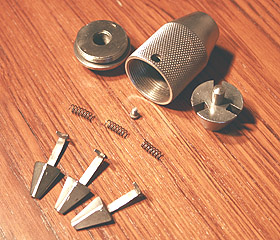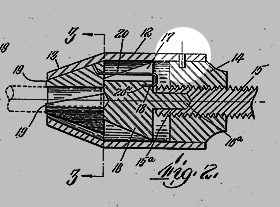 Implementation of this chuck was a dramatic departure from chucks
previously used by Millers Falls Co. on hand drills.
Implementation of this chuck was a dramatic departure from chucks
previously used by Millers Falls Co. on hand drills.
It is
one of the first, if not the first, spring-based chuck the
company installed on hand drill. It offered capacity
from 0 to 3/8 inch for bits with round shank and for the first
time users didn't need to manipulate jaws to open them.
Just as with McCoy's spring-less chuck, there are at least two
variations of this chuck. Version first produced had patent information: "Millers
Falls Co., Millers Falls, Mass. Pat'd October 23, 1900" on
the chuck's shell. Later production runs and found most
often, do not have these markings.
One of the important characteristics of this chuck is a locking
screw in the chuck's body. Just as with McCoy's chuck, it
was used to secure shell to a cap and prevent separation of
these parts. I used this characteristic for some time to
quickly differentiate between Parsons' chuck and another chuck,
used extensively by Millers Falls and patented by Henry A. Ryther
in 1922. Since I never seen a Ryther's chuck with locking
screw, this sounded as a reasonable practice. Until...
surprise, surprise...
 After
disassembling several dozens of chucks on No. 2 drills and being
most certain that the chuck at hand is another Parsons' design,
I took the shell of and... here it is... the Ryther's
chuck with "S" springs! Another review of the Ryther's
patent shows provision for a locking screw. Since then
(Spring, 2008) I have seen and worked on several of Ryther's
chucks with a locking screw.
After
disassembling several dozens of chucks on No. 2 drills and being
most certain that the chuck at hand is another Parsons' design,
I took the shell of and... here it is... the Ryther's
chuck with "S" springs! Another review of the Ryther's
patent shows provision for a locking screw. Since then
(Spring, 2008) I have seen and worked on several of Ryther's
chucks with a locking screw.
Back to the Parsons' chuck....
I have seen this chuck on hand drills No. 2 and No.7. The
earliest example of the chuck I have seen is on the No. 2 hand
drill from c. 1906. The condition of this specific
specimen is very good. The marking on the shell are clear
and chuck's operation is flawless.
